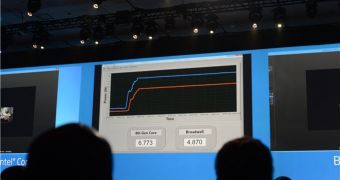Intel's Broadwell central processing unit line will succeed Haswell before the year is out, which means that product demos are finally happening. The one we have just learned about took place at IDF 2013.
Broadwell will come after Haswell. Systems based on them aren't expected to make their appearance until next year (2014), but the same can't go for the chips themselves.
Which is to say, Broadwell silicon will reach customers (motherboard makers, system builders, etc.) by the end of the year.
Among the many processors, there will be some bearing the moniker Broadwell ULT, where ULT stands for Ultrabook.
They will be less energy-intensive than the usual chips, but not to the same extent as Broadwell-ULX. Assuming Intel actually makes ULX Series units (for tablets and particularly stingy ultrabooks).
It wasn't totally clear how many watts Broadwell-ULT processors would operate on, but Intel did say that the reduction in power, while maintaining the performance level, would be of 30%.
In fact, Intel held a demo where it showed what it meant. So, knowing that Haswell-ULT work at 13.5W or 15W, Broadwell-ULX would, presumably, settle for 8 W to 10W, or thereabouts.
That said, Broadwell-ULT will have two dies in a single MCM (multi-chip module), but will be physically smaller than Haswell-ULT. Understandably, given the leap from 22nm to the 14nm manufacturing process technology.
I assume that the 2014 edition of the Consumer Electronics Show in January will at least have a few prototype ultrabooks to show off, even if the actual product wave doesn't come until months later.
The Intel Developer Forum is taking place in San Francisco, California, between September 10 and 12.
The release of Ivy Bridge-E and Ivy Bridge-EP processors stole most of the show, as did OEM motherboards and the like, but Broadwell is making waves too.

 14 DAY TRIAL //
14 DAY TRIAL //